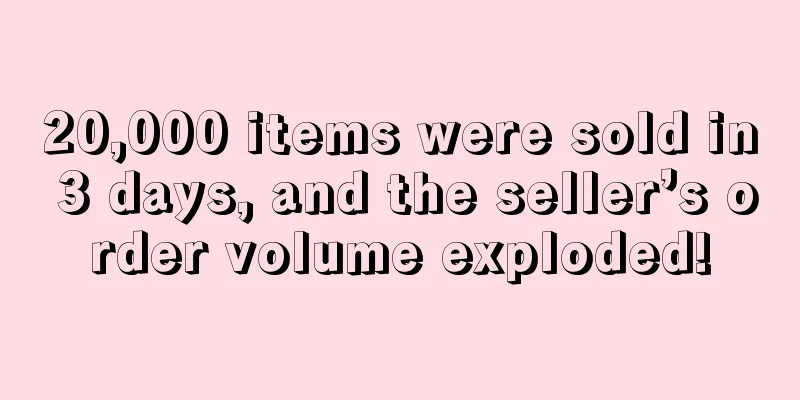Important! Amazon limits total account replenishment, all European and American sites affected

|
Two days ago, a business manager revealed that Amazon was going to tighten FBA shipping restrictions again. This morning, the news that Amazon began to limit the total shipping volume of accounts spread, and all sites in the United States, Canada, and Europe were affected, and sellers almost went crazy.
Cancel ASIN delivery restrictions, Amazon limits the total replenishment volume of accounts
Previously, Amazon stipulated that as long as the IPI score met the standard, only a single ASIN would be restricted from replenishment. Now, Amazon’s policy has changed, canceling the ASIN shipment restriction and limiting the replenishment quantity of the entire account instead, which does not help even if the IPI score meets the standard.
For many sellers, this was a thunderbolt. Sellers were discussing:
“Suddenly, there is an additional replenishment restriction. Is it not enough to limit the individual ASINs? Do we also have to limit the total shipment quantity?” "Does that mean we can't restock? We can't create shipments in the backend anymore." "I came in this morning and it exploded... I couldn't send a single one." "If something goes wrong, the storage capacity will drop to 1/4."
One seller directly posted the backend page, showing "unlimited" replenishment in each category , but the account showed "replenishment restrictions".
Amazon has issued a statement on this matter:
Amazon explained the policy change this way:
“We made changes to our ASIN-level quantity limits to ensure we can receive and store product for all sellers using FBA.
Beginning April 22, 2021, FBA products will no longer be subject to quantity limits at the ASIN level. Instead, inbound limits will be set at the storage type level, giving you more flexibility in managing your shipments.”
Amazon responded to some common questions regarding replenishment restrictions at the warehouse type level:
1. How to determine replenishment limits at the storage type level ?
Replenishment limits are determined by storage type and can be allocated across your ASINs based on your historical and projected sales. To view replenishment limits and usage at the storage type level, you can view them through Inventory Performance or Shipment Progress (expand the Replenishment Limit Monitor at the bottom of the page). Your account will no longer be subject to ASIN quantity limits.
2. How do I determine how much inventory I can send ?
Go to Replenishment Limits Monitor and [Check Maximum Shipment Quantity by Storage Type]. This can be applied to your ASINs as per your choice without having to follow ASIN level unit quantity limits.
Important : Shipping an inventory item in quantities that exceed the maximum allowed shipment quantity is a policy violation and may result in the cancellation of the non-compliant shipment.
3. How does Amazon calculate the maximum number of shipments allowed ?
The Maximum Shipment Quantity you can send is equal to the Maximum Allowed Inventory Level minus the Inventory Limit Usage. To view utilization, go to the Replenishment Limits monitor and check [Utilization by Storage Type].
Inventory limit usage counts toward your maximum inventory level and is used to determine the maximum number of shipments you can send. Inventory limit usage includes your current inventory, inbound shipments, inventory to be removed, and reserved inventory. This value may or may not be the same as the Amazon Inventory Supply value.
European and American sites were all affected, and distribution stores were hit hard
According to sellers’ feedback, the new policy has been implemented on the US, European and Canadian sites. Amazon’s sudden move caught many sellers off guard.
Sellers analyzed that Amazon currently has two restrictions on shipments: 1. Restriction on inventory volume. If the IPI score is not reached, it cannot exceed a certain volume; 2. Restriction on the total number of inventory items. The original ASIN-level replenishment restrictions have disappeared and have become total quantity restrictions. Amazon wants everyone to stock up on superior products and give up on products that are not doing well. "My FBA warehouse is to make money, so the higher the turnover rate, the better." The seller joked.
What impact will the new policy have on sellers?
One seller gave a real example: "Yesterday I could send more than 30,000 pieces by sea freight. Today I can only send 2,000 pieces. I don't dare to send them by sea freight, but air freight is only 60 to 70 yuan per kilogram, so I can't afford it."
Currently, two types of accounts are most affected:
The lifting of ASIN restrictions and the restriction of the total number of accounts are fatal to the sellers of the distribution type. Stores with multiple ASINs are impacted, and large stores with fine distribution are facing challenges, while stores and overseas warehouses may usher in a new spring. "The only way out now is to increase sales, and we can only do fine products. There is no way to do fine distribution and distribution." said a seller.
New stores. Currently, many new stores are unable to ship directly. One seller said: "The number of new stores that have just been opened is limited. New products cannot be shipped and old products cannot be received!" The total inventory is scarce, and new sellers are more affected.
In addition, many sellers have shipped goods before, but according to the new regulations, the shipment quantity has exceeded the limit. How Amazon judges such problems and whether there will be fines are also of concern to sellers.
This passive situation once again makes sellers sigh: What defeats you is never your competitors, but Amazon’s policies. When you wake up from a sleep, you never know what will happen tomorrow.
The price war was fierce, and many sellers' orders fell sharply
In addition, in the past two days, another wave of order decline has hit. Many sellers reported that orders have decreased, and there are particularly few orders this week.
One seller asked: Are we the only ones who don't place orders? Then the responses from multiple sellers showed that he was not alone.
Among the many feedbacks, one seller said that orders had plummeted. Another seller said that sales were so poor that they did not want to restock.
In fact, since the beginning of this month, many sellers have gradually felt the impact of reduced orders and traffic. One seller lamented: "The traffic in April was so weak that I doubted my life."
The decrease in orders in April was particularly evident on the 9th and 22nd.
In the early morning of the 22nd (yesterday), many sellers reported that many links on Amazon suddenly disappeared. About an hour later, the system returned to normal. One seller said that the Amazon system was out of order, and after looking at the company's ERP, the overall order volume during that period was affected .
When orders dropped on April 9, many sellers could not find the reason until a seller recently received an email showing that Amazon had experienced a delay in displaying, updating or editing at 8:00 a.m. Pacific Time on April 9. This situation lasted for several hours. However, the platform said that there was no loss of data or impact on advertising services.
In addition to the possible impact of system problems, one of the reasons for the small number of orders is: capital entering the market, fierce price wars , and some sellers frantically reducing prices without placing orders.
One seller said that the price of a summer product is not as good as that in 2020, and is even lower than that in 2019. The price war this year is too fierce.
Another seller lamented: Last year, the category that was originally very comfortable was turned upside down by a group of sellers engaged in price wars. I lost money on every sale, and I did not have the strength to deliver a whole cabinet directly, so in the end I had to exit the market in disgrace, which caused me to suffer heavy losses.
Many peers in the industry share the same feeling. This year, not only many new sellers have entered the market, but also a lot of capital has poured in to stir up trouble. One seller said frankly that when he saw the price, he always felt that other people bought the goods at a lower price, but after calculating again and again, even if he bought the goods at the lowest price, he still had no profit from the selling price. He didn't know what his peers were looking for!
Moreover, even though the UK VAT is being paid by the UK, and many sellers’ profits have shrunk by about 20%, there are still many sellers who have not raised their prices, but are lowering them instead. Recently, other EU sites have also received news that Amazon will withhold VAT after July 1, but some sellers are still continuing to lower their prices.
Nowadays, the price war in many categories of Amazon is very fierce. Some people even sell at half the price of their peers. This operation has been complained by many people: "It's really crazy. The Chinese people are hurting each other in the price war, which makes the foreigners cheaper. Isn't it good for everyone to make foreign currency happily together? " USA, Order, FBA |
<<: German luxury e-commerce company Mytheresa is expanding into the U.S.
>>: Zebao won the bet and successfully achieved a net profit of 443 million yuan in three years!
Recommend
Shopify is building its own marketplace — Shop
Shopify once claimed that it would not build its ...
The epidemic, inflation, and supply chain disruptions caused the decline in US retail spending to exceed expectations
Americans' retail spending fell more than exp...
Amazon's first deployment in Central China encourages sellers to cultivate well-known overseas brands
Guangzhou and Shenzhen have long been gathering p...
What is Shop Box? Shop Box Review, Features
The ShopBox product is designed to provide a safe...
What is Market Kurly? Market Kurly Review, Features
Founded in 2015, Market Kurly is a platform that ...
What is OpenCart? OpenCart Review, Features
OpenCart is an easy-to-use, powerful open source ...
Orders were placed within seconds of listing! Search volume increased by 400%, and this product suddenly became popular
The new year has begun, but there are still many ...
With a price increase of nearly 90%, emergency products top the Amazon Best Sellers list
Under the continued impact of the Russia-Ukraine ...
What is lauraartcouk? lauraartcouk Review, Features
LauraArtcouk has been adhering to the concept of &...
Earth Day 2022: SHEIN joins environmental groups to protect forests
On April 22, World Earth Day, SHEIN announced on ...
What is Gwynnie Bee? Gwynnie Bee Review, Features
Gwynnie Bee is an online fashion retailer that of...
Nearly 80,000 domestic ceiling fans were recalled, causing 60 falling accidents
Recalls are frequent and involve a variety of cat...
What is uspartscenter? uspartscenter Review, Features
USPartsCenter is dedicated to assisting customers ...
With overall product prices 10% lower, Amazon firmly sits on the throne of the “cheapest e-commerce” in Europe and the United States!
Recently, Profitero, a global e-commerce analysis...
Important notice: Sellers' profits have shrunk by 20%! Amazon will pay all European VAT on their behalf
In January this year , Amazon began to collect an...









